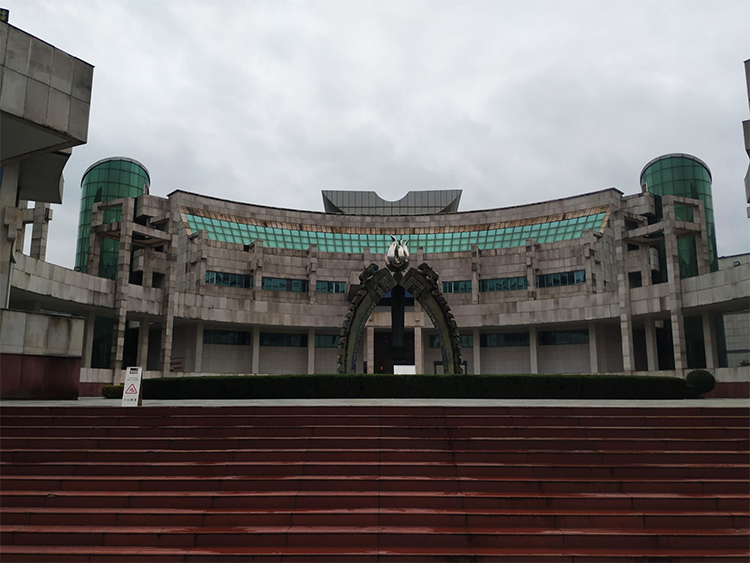Discover Jingdezhen Porcelain at Jiangxi Museum: Bronze and Ceramic Treasures
Introduction
When sunlight brushes the bronze-patterned façade of the Jiangxi Provincial Museum, the modern building—shaped like a Jingdezhen blue‑white porcelain cup—feels infused with ancient charm. More than a regional archive, the museum stages a time-crossing dialogue: the weight of Shang–Zhou bronzes, the clarity of Jingdezhen porcelain, and the solitary ink of Bada Shanren all converge across 86,000 square meters. As a national first‑class museum with 100,000 artifacts, it tells the story of Gan–Po civilization from the Neolithic to modern times—waiting for you to walk its floors and meet its treasures.
1. Architecture: When Celadon Meets Bronze, a Museum That Tells Stories
Opened in 2020, the new building is itself a monumental exhibit. Designers borrowed lines from the classic Jingdezhen fangdou cup so the silhouette reads like a refined celadon vessel; the exterior is embossed with coiled‑dragon and thunder patterns taken from local bronze finds. The result is a dramatic conversation between traditional motifs and contemporary steel. Step into the 30‑meter‑high “Porcelain Light Hall”: natural light paints ever‑changing shadow stories across white ceramic panels, drawing visitors into a calm, contemplative space.
2. Must‑See Treasures: Three Cultural Keys You Can’t Miss
– Shang Dynasty Double‑tailed Bronze Tiger (2nd floor, Ancient History Gallery): The nation’s only double‑tailed bronze tiger—sporting a small bird on its back—pairs fierce power with delicate motion. X‑ray scans reveal a 3,000‑year‑old clay casting core inside, earning it the nickname “the mummy of bronzeware.”
– Yuan Blue‑and‑White Glaze Ware Granary with Figures (3rd floor, Ancient Ceramics Gallery): One of only two known examples worldwide, this 29‑cm high painted ceramic granary compresses Jiangnan pavilions, music, and daily life into miniature form—details even include tiny hinge-style doors. Often called a “frozen Yuan‑dynasty Riverside Scene.”
– Bada Shanren’s “Pine and Deer” Scroll (4th floor, Calligraphy & Painting): The Jiangxi native Bada Shanren is famous for animal paintings that glance skyward; here the deer’s unusually gentle eye and the dry‑brush pines hint at the artist’s late‑life calm. Scholars frequently pause for long study in front of this work.

3. Curatorial Narrative: Four Threads That Decode Jiangxi’s DNA
The museum organizes its permanent displays into four thematic lines to build layered understanding:
– “Gan Land Treasury” (Ancient History): From the millennia‑old Xianren Cave rice remains to the Wu City bronze culture, vitrines of patinated bronze chime instruments sit beside multimedia reconstructions of ritual scenes.
– “Red Cradle” (Revolutionary History): Manuscripts like Fang Zhimin’s beloved essays and a re‑creation of the Jinggangshan meeting reveal why Jiangxi became a revolutionary hub.
– “Ceramics: Technology and Craft”: Interactive screens dissect ceramic body layers while VR transports visitors into a Ming imperial kiln for hands‑on wheel‑throwing and glazing.
– “Living Intangible Heritage”: Weekly Gan‑nan tea‑picking opera and handwoven summer cloth workshops keep traditions alive.

4. Immersive Experiences: Cultural Adventure in the Digital Age
– AR Treasure Hunt: Pick up a tablet at the desk and scan select objects to see historical figures come alive and narrate their stories; English audio is available.
– Overnight at the Museum: Monthly “Guardian of Relics” sleepovers let families camp beside dinosaur fossils and wake to an empty bronze hall bathed in morning light.
– Hidden Easter Eggs: At the far end of the 3rd‑floor “Ceramic Road” gallery, press the Poyang Lake map


